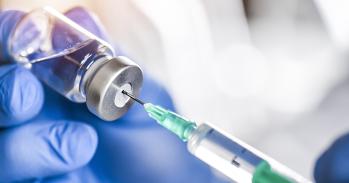
In order to reduce the transmission of HIV from mother to baby during breastfeeding, scientists are developing a low-cost, modified nipple shield which dispenses antiviral compounds.
In order to reduce the transmission of HIV from mother to baby during breastfeeding, scientists are developing a low-cost, modified nipple shield which dispenses antiviral compounds.
This may also be an easier method of delivery than using oral syrup syringes, the current advised method of administration, and provide a new route for the delivery of many infant medications and nutritional supplements.
Stephen Gerrard
The novel research is highlighted in the following film.
Scientists at the University of Cambridge, with collaborators from the United States, are modifying a conventional nipple shield to include replaceable inserts. These inserts will contain an anti-viral agent which will be delivered to the infant while breastfeeding to prevent HIV infection from an HIV+ mother.
They are currently exploring a number of cheap, edible microbicides which are deposited on the insert and released into the milk during breastfeeding, significantly reducing the HIV infectivity in the breast milk.
Breastfeeding accounts for up to one third of all mother-to-child transmissions of HIV, approximately 200,000 babies every year, primarily in Sub-Saharan Africa. Unfortunately, the mothers often have no alternative but to breastfeed as formula is typically even more deadly for the infant than the risk of HIV infection (due to the malnutrition and diarrhoea it often causes when used in low resource settings).
Stephen Gerrard, a PhD candidate at the Department of Chemical Engineering and Biotechnology at the University of Cambridge, stated: "The nipple shield could also deliver anti-retroviral drugs (ARVs) to non-infected infants - infant ARV prophylaxes (medicines given to prevent disease) is recommended by the World Health Organization if there is no acceptable, feasible, affordable, sustainable and safe alternative to breastfeeding for an HIV+ mother to her infant.
"This may also be an easier method of delivery than using oral syrup syringes, the current advised method of administration, and provide a new route for the delivery of many infant medications and nutritional supplements."
The 'JustMilk' project stemmed from the International Design Development Summit 2008, for more information visit hpp://justmilk.org.
Scientists at the University of Cambridge, with collaborators from the United States, are modifying a conventional nipple shield to include replaceable inserts. These inserts will contain an anti-viral agent which will be delivered to the infant while breastfeeding to prevent HIV infection from an HIV+ mother.
They are currently exploring a number of cheap, edible microbicides which are deposited on the insert and released into the milk during breastfeeding, significantly reducing the HIV infectivity in the breast milk.
Breastfeeding accounts for up to one third of all mother-to-child transmissions of HIV, approximately 200,000 babies every year, primarily in Sub-Saharan Africa. Unfortunately, the mothers often have no alternative but to breastfeed as formula is typically even more deadly for the infant than the risk of HIV infection (due to the malnutrition and diarrhoea it often causes when used in low resource settings).
Stephen Gerrard, a PhD candidate at the Department of Chemical Engineering and Biotechnology at the University of Cambridge, stated: "The nipple shield could also deliver anti-retroviral drugs (ARVs) to non-infected infants - infant ARV prophylaxes (medicines given to prevent disease) is recommended by the World Health Organization if there is no acceptable, feasible, affordable, sustainable and safe alternative to breastfeeding for an HIV+ mother to her infant.
"This may also be an easier method of delivery than using oral syrup syringes, the current advised method of administration, and provide a new route for the delivery of many infant medications and nutritional supplements."
The 'JustMilk' project stemmed from the International Design Development Summit 2008, for more information visit www.justmilk.org.
This work is licensed under a Creative Commons Licence. If you use this content on your site please link back to this page.





